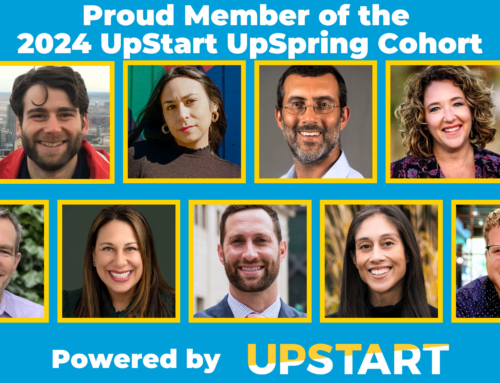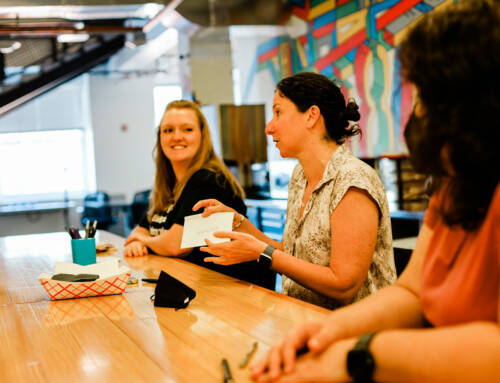Establishing the Baseline Reality: Who? What? Where?
An improviser’s first and foremost task is to establish the world in which a scene takes place. You can’t check in with the other actors before a scene and make decisions about the environment in advance. Once you initiate a scene, you quickly have to make clear to your partner—and the audience—who you are, where you are, and what you are doing. This is called establishing a “baseline reality.” From that reality, you can go almost anywhere. And when you and your fellow actors do change things up, the impact will be that much more apparent, because everyone already understands the starting point.
Similarly, in the social sector, organizations must be clear about who they are, what they are doing, and where they are doing it. This is starkly apparent in fundraising; it is difficult to show potential funders why your organization deserves support when you can’t differentiate what you do from what another organization does. It’s also true for organizations’ programming, marketing, and internal workings. Can everyone on your staff share the organization’s “baseline reality” within one or two sentences? They should be able to.
The “Why”
Articulating a baseline reality in improv is important, but it doesn’t tell the full story. A scene can take off only when a character’s point of view is clear. Imagine an improv scenario where a character thinks of her pet fish as a friend and takes the fish clothes shopping. Well, then she might take her fish to the movies. Or to an important work event. The combination of play with this unusual behavior, the reason behind it, and the escalation of that behavior because of that reason that makes the scenario work.
Simon Sinek has popularized the importance of starting with why to ensure that organizations are clear about the difference they want to make in the world. What is the reason behind what your organization does? This is like adding the words “because” to your baseline reality.
Progress on social issues can be slow and difficult to measure. Helping your employees and volunteers connect to the organization’s overarching why can help provide ongoing excitement and energy around their work. Can your staff and volunteers connect your organization’s mission to what they do?
Support
The best improv troupes operate as a united front. They rally around their partners’ ideas—wildly, irrationally, and ridiculously supporting them. If one player creates a baseline reality that is an “animal prom,” for example, the rest of the troupe is neighing, hissing, and lowing along. In improv, this is called support. The concept of “yes, and,” popularized by Tina Fey in her memoir Bossypants is one aspect of this support; the idea is that a scene will work only if you don’t judge or shut down your partner’s ideas, but instead build on them, adding your own creative direction to what is already established.
Learning how to support others by accepting and building on their ideas is critical to the success of social sector organizations. An organization’s staff members must work as a team; each part must be aware and supportive of the work and ideas of the other parts; and everyone working in the system must strive, together, to complement each other’s practices and serve the greater whole. Only in this way can it meet the evolving needs of the people it is striving to help.
Listening
In the Upright Citizens Brigade Comedy Improvisation Manual, authors Matt Besser, Ian Roberts, and Matt Walsh, explain how critical careful listening is:
You should be listening carefully to every line to determine how your scene partner is setting you both up … if you are listening, then you will be able to react accordingly …
In other words, if you can be truly present and genuinely open to your scene partner, and can intelligently listen and honestly respond when you are improvising, you are much more likely to create an engaging, funny scene for your audience.
It is similarly essential in the social sector to create a true culture of listening—starting within the organization, ensuring that the multiple perspectives of the various stakeholder groups are heard, and then moving beyond the organization to ensure that the multiple constituencies the organization is serving are heard as well. If everyone is going through the motions without taking the time or making the effort to listen, they may miss opportunities to improve a program or help an individual overcome a challenge.
Last year, I co-facilitated a program that exposed teachers in the New York area to a variety of innovation tools, including some concepts from the world of improv. One school (encouraged by its Head of School, who said, “Education today is much more complex than in the past [and] educators today need to be not only educators, but innovators”) used these tools to reinvent its faculty meetings. Specifically, it stopped having large weekly faculty meetings and instead established a more flexible approach, where small groups of faculty could meet at their convenience to tackle shared challenges.
As one teacher who participated in the shift reflected: “I learned that it doesn’t matter who you are and what your position is. It’s really about people coming together and sharing ideas. Once people [could] feed off each other … it exploded and grew, and we got to a place none of us imagined we could get to.”
The structures and philosophy of the art of improv can help nonprofits stay grounded in what they are, while simultaneously allowing them to creatively and effectively respond to the ever-evolving needs of the people they strive to serve. I believe that if more organizations in the social sector embraced these simple structures—establishing a baseline reality, connecting to why they do what they do, and working with a culture of support and listening—the entire sector could be more impactful.
Originally published on the Stanford Social Innovation Review blog.
Our purpose is to enable entrepreneurs to bring bold Jewish ideas to light. We help them reach Up to people in new ways that are meaningful, more inclusive, and create a brighter future for our Jewish community and the world we share.





